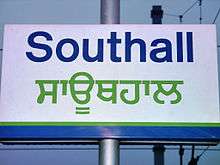Southall
Southall (English: /ˈsaʊθɔːl/) is a large suburban district of west London, England, and part of the London Borough of Ealing. It is situated 10.7 miles (17.2 km) west of Charing Cross. Neighbouring places include Yeading, Hayes, Hanwell, Hounslow, Greenford and Northolt. The area is identified in the London Plan as one of 35 major centres in Greater London.[3] It had a population of 69,857 as of 2011.[4]
| Southall | |
|---|---|
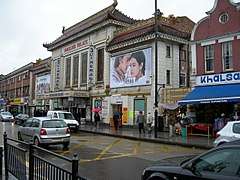 South Road | |
 Southall Location within Greater London | |
| Population | 69,857 (2011 Census[1][2] |
| OS grid reference | TQ125805 |
| • Charing Cross | 10.7 mi (17.2 km) W |
| London borough | |
| Ceremonial county | Greater London |
| Region | |
| Country | England |
| Sovereign state | United Kingdom |
| Post town | SOUTHALL |
| Postcode district | UB1, UB2 |
| Dialling code | 020 |
| Police | Metropolitan |
| Fire | London |
| Ambulance | London |
| UK Parliament | |
| London Assembly | |
Southall is located on the Grand Union Canal (formerly the Grand Junction Canal) which first linked London with the rest of the growing canal system. It was one of the last canals to carry significant commercial traffic (through the 1950s) and is still open to traffic and is used by pleasure craft. It is generally divided in three parts: the area around Lady Margaret Road (sometimes called Dormers Wells); Southall Broadway (including the Uxbridge Road), and Old Southall/Southall Green to the south. The area is home to London's largest Sikh community[5] and is a major centre of South Asian culture,[6] having gained the nickname Little India.[7]
Toponymy
The name Southall derives from the Anglo-Saxon dative æt súð healum, "At the south corner (of the land or wood)" and súð heal, "South corner" and separates it from Northolt which was originally norþ heal, "North corner" which through a later association with Anglo-Saxon holt, "Wood, copse" developed into Northolt.
Shown on an old Elizabethan Tapestry as Southold with neighbouring Northold and Horwood
The district of Southall has many other Anglo-Saxon place-names such as Elthorne and Waxlow. Its earliest record, from ad 830, is of Warberdus bequeathing Norwood Manor and Southall Manor to the archbishops of Canterbury.
History
_Portrait_of_Robert_Cheseman_(1485-1547)_Mauritshuis_276.jpg)
Southall formed part of the chapelry of Norwood in the ancient parish of Hayes, in the Elthorne hundred of Middlesex.[8] For Poor Law it was grouped into the Uxbridge Union and was within Uxbridge Rural Sanitary District from 1875. The chapelry of Norwood had functioned as a separate parish since the Middle Ages. On 16 January 1891 the parish adopted the Local Government Act 1858 and the Southall Norwood Local Government District was formed. In 1894 it became the Southall Norwood Urban District.[8] In 1936 the urban district was granted a charter of incorporation and became a municipal borough, renamed Southall.[9] In 1965 the former area of the borough was merged with that of the boroughs of Ealing and Acton to form the London Borough of Ealing in Greater London.[10]
The southern part of Southall (roughly south of the railway) used to be known as either Old Southall or Southall Green (and a section of the main north–south road in the area is still called The Green) and was centred on the historic Grade II* listed Tudor-styled Manor House[11] which dates back to at least 1587. A building survey has shown much of the building is original, dating back to the days when Southall Green was becoming a quiet rural village. Minor 19th and 20th century additions exist in some areas. It is currently used as serviced offices.[12]
The extreme southernmost part of Southall is known as Norwood Green. It has few industries and is mainly a residential area, having remained for many years mainly agricultural whilst the rest of Southall developed industrially. Norwood Green borders, and part is inside, the London Borough of Hounslow.
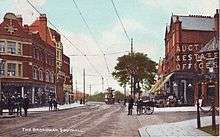
The main east west road through the town is Uxbridge Road (A4020), though the name changes in the main shopping area to The Broadway and for an even shorter section to High Street. Uxbridge Road was part of the main London to Oxford stagecoach route for many years and remained the main route to Oxford until the building of the Western Avenue highway to the north of Southall in the first half of the 20th century. First horse drawn, then electric trams (until 1936) and, then, electric trolleybuses, gave Southall residents and workers quick and convenient transport along Uxbridge Road in the first half of the 20th century before they were replaced by standard diesel-engined buses in 1960.[13]
19th century
The opening of the Grand Junction Canal (later renamed Grand Union Canal) as the major freight transport route between London and Birmingham in 1796 began a commercial boom, intensified by the arrival of Brunel's Great Western Railway in 1839, leading to the establishment and growth of brick factories, flour mills and chemical plants which formed the town's commercial base. In 1877, the Martin Brothers set up a ceramics factory in an old soap works next to the canal and until 1923, produced distinctive ceramics now known and collected as Martinware.
A branch railway line from Southall railway station to the Brentford Dock on the Thames was also built by Isambard Kingdom Brunel in 1856. It features one of his (impressive for the period) engineering works, the Three Bridges (although it is still often referred to on maps by the original canal crossing name of Windmill Bridge). where Windmill Lane, the railway and the Grand Union Canal all intersect – the canal being carried over the railway line cutting below in a cast-iron trough and a new cast-iron road-bridge going over both. Brunel died shortly after its completion. Sections of his bell-section rail can still be seen on the southern side being used as both fencing posts and a rope rail directly under the road bridge itself. It is listed as a Scheduled Ancient Monument. The other notable local construction by Brunel is the Wharncliffe Viaduct which carries the Great Western Railway across the River Brent towards London and which was Brunel's first major structural design.
Otto Monsted, a Danish margarine manufacturer, built a large factory at Southall in 1894. The factory was called the Maypole Dairy, and eventually grew to become one of the largest margarine manufacturing plants in the world, occupying a 28 hectares (69 acres) site at its peak. The factory also had its own railway sidings and branch canal. The Maypole Dairy Company was later acquired by Lever Brothers who, as part of the multinational Unilever company, converted the site to a Wall's Sausages factory which produced sausages and other meat products through until the late 1980s.
20th century
At the beginning of the twentieth century, the old parish church of Southall, St John's, which had been rebuilt in 1837–8, was found to be too small for its congregation and, as a result, emigrated to a new building in Church Avenue, which was completed in 1910. The original church building, in Western Road, is now a youth centre.[14]
The Quaker Oats Company built a factory in Southall in 1936. Part of the operation that made pet foods was sold to Spiller's in 1994, and the remainder to Big Bear Group in 2006. The site continues to produce brands such as Sugar Puffs. Other engineering, paint and food processing factories prospered for many years, mostly alongside the railway and/or canal. A collection of Martinware – salt-glazed stoneware, and birds – is on display at Southall Library.
On the eastern boundary of Southall was the Hanwell Asylum, once the world's largest asylum for the mentally ill. It was considered in its day to be a progressive institution with a good success rate for treatment. As attitudes to and treatment for mental illness improved, the site was renamed St. Bernard's Hospital. In the late 1970s, the site was extensively redeveloped, with most of the area now taken up by the Ealing Hospital. St. Bernard's still operates a large facility on part of the site under the West London Mental Health (NHS) Trust.
Southall was the home of Southall Studios, one of the earliest British film studios. It played a historic role in film-making from its creation in 1924 to its closure in 1959. In 1936, a fire destroyed the studio but it was rebuilt and enlarged. Numerous feature films (many featuring famous or later-to-be-famous actors) and the early TV series Colonel March of Scotland Yard were made at the studios, as were TV and cinema adverts.[15]
There has been a locomotive works at the Southall Depot for nearly 150 years. Originally a Great Western Railway shed, it was possibly the last London steam depot, outlasting Old Oak Common and Stewarts Lane depots. The depot was later used for DMU maintenance and as a base for the electrification programme. Currently the site, now referred to as the Southall Railway Centre, is used by three independent groups; the Great Western Railway Preservation Group, Locomotive Services Limited and West Coast Railways.
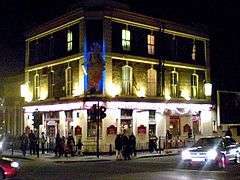
The bus and commercial vehicle manufacturer Associated Equipment Company (AEC) was based in Southall, on a 25 hectares (62 acres) triangular site between Windmill Lane, the Great Western Main Line and the branch to Brentford Dock. The company moved there from Walthamstow in 1926 and closed in 1979 after losing market share whilst part of the giant but inefficient British Leyland group. The site was noticeable to railway passengers and to motorists on Uxbridge Road due to large signs proclaiming "AEC – Builders of London's Buses for 50 years".
A major gas works manufacturing town gas was located between the railway and the canal. In 1932 a large gasholder was built which has been a noticeable landmark ever since as it can be easily observed from a long distance away. Painted on the north east side of the gasholder are the large letters 'LH' and an arrow to assist pilots locate Heathrow Airport's (now closed) runway 23 when making visual approaches. The letters were painted in the mid 1960s after a number of pilots became confused between Heathrow and the nearby RAF Northolt (which has a similar, though smaller, gasholder under its approach at Harrow). Northolt has a much shorter runway and is not suitable for very large aircraft although one Boeing 707 did land at Northolt by mistake[16] and a number of other aircraft had to be warned off by air traffic control at the last minute. Since town gas production ceased in the 1970s with the arrival of natural gas piped from the North Sea, much of the 36 hectares (89 acres) site has been vacant, due to limited road access and remaining gas infrastructure.
During World War II Southall was the target of enemy bombing on a number of occasions. A German V-1 flying bomb destroyed a number of houses in Regina Road, killing the occupants.[17] Bomb shelters and bunkers were built during the war, close to or under most schools and public buildings. The bunkers at Hamborough Primary School were expanded during the Cold War, to become the North West Group War HQ for the London area Civil Defence organisation and the London Borough of Ealing Emergency Control Centre. This facility is now disused.[18]
On 2 September 1958 at 7:10 am, a pilot of a Vickers Viking V624 (G-AIJE), which had just taken off from Heathrow Airport, reported that he had engine trouble. Some minutes later it crashed onto houses in Kelvin Gardens. It was on a cargo flight carrying aero engines to Tel Aviv and carried no passengers; however, the three crew members and four people on the ground were killed. One of the surviving occupants, 14-year-old Brian Gibbons, was later awarded the George Medal for bravery, as well as the Carnegie Award.[19] The accident was due to poor maintenance, and caused the company, Independent Air Travel, to fail in October 1959.[20]
In the 1970s saw racial tensions in the area; in 1976 Sikh teenager Gurdip Singh Chaggar was killed in a racist attack.[21] On 23 April 1979, Blair Peach, a teacher and anti-racist activist, was killed after being knocked unconscious during a protest against the National Front (NF)..[22][23] Another demonstrator, Clarence Baker – a singer of the reggae band Misty in Roots, remained in a coma for five months.[24] More than 40 others – including 21 police – were injured, and 300 were arrested.[25]
On 4 July 1981, a race riot was sparked at the Hambrough Tavern on the Broadway.[26] Local Asian youths mistakenly believed that a concert featuring the Oi! bands The Business, The Last Resort and The 4-Skins was a white power event.[27] Additionally, the venue had recently been sued for barring non-white customers, and local youths had heard that skinheads arriving for the concert had harassed other youths and women.[28] More than 200 skinheads had travelled by bus from East London, and a few of them smashed shop windows,[29] wrote NF slogans around the area,[30] and shouted neo-Nazi slogans while using bricks and clubs to attack Asian youths who had gathered in opposition to the gig. This was one of several high-profile riots in Britain that year.
Although some of the skinheads were NF or British Movement supporters, among the 500 or so concert-goers were also left-wing skinheads, black skinheads, punk rockers, rockabillies and non-affiliated youths.[31] Some of the approximately 400 Asians threw petrol bombs and other objects, and five hours of rioting left 120 people injured – including 60 police officers – and the tavern burnt down.[26][32]
The Southall rail crash occurred on 19 September 1997 when a First Great Western mainline high speed express train from Swansea to London Paddington ran a red signal, when the driver's attention was distracted, and it collided with a goods train just outside Southall railway station. Seven people died and 139 were injured.
Culture
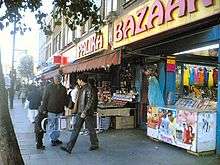
Southall is primarily a South Asian residential district, sometimes known as "Little India".[33][34][35][36][37] In 1950, the first group of South Asians arrived in Southall, reputedly recruited to work in a local factory owned by a former British Indian Army officer. This South Asian population grew, due to the closeness of expanding employment opportunities such as Heathrow Airport. The most significant cultural group to settle in Southall are Asians. According to the Commission for Racial Equality, over 55% of Southall's population of 70,000 is Indian/Pakistani.[38][39] There are ten Sikh Gurdwaras in Southall. The Gurdwara Sri Guru Singh Sabha, which opened in 2003, is one of the largest Sikh gurdwaras outside India, and it won the Ealing Civic Society Architectural Award in 2003. There are two large Hindu 'Mandir' temples, the Vishnu Hindu Mandir on Lady Margaret Road and the Ram Mandir in Old Southall. There are more than ten Christian churches including 5 Anglican, one Roman Catholic (St Anselm's Church), Baptist, Methodist and several Pentecostal or Independent. There are six Mosques 'Masjids' in Southall, the Abubakr Mosque situated on Southall broadway, the Central Jamia Masjid Mosque, which is the oldest, the Jamia Masjid Islamic Centre, the Red Sea Mosque on the Green, and Dar al Salam on Norwood Road and also the Baithul Mukaram mosque near Lidil.[40]
In addition, the signs on the main railway station are bilingual in English and Gurmukhi, which is one of the written scripts of Punjabi.
Earlier, in the 1920s and 1930s Southall was the destination of many Welsh migrants escaping from the harsh economic conditions in that part of the country. For many years, Welsh accents were very commonplace in the area.[41]
The main street in Southall is called The Broadway. Southall contains the largest South Asian shopping area within the M25. Southall was also the main location for the internationally acclaimed film Bend It Like Beckham.
Southall was also the location of the famed Glassy Junction public house, which was the first pub in the UK to accept Indian Rupees as payment. The Glassy Junction closed down in 2011 and has since been replaced by an international South Indian restaurant chain.
The Brilliant Restaurant also appeared on TV Ramseys Best Restaurants and was nominated but failed to win any awards. Southall has also appeared in other Bollywood films as well, including Patiala House and Goal!.
Other notable local pubs include The Three Horseshoes in Southall Broadway, by the architect Nowell Parr which closed in 2017.
There are two local community radio stations servicing Southall; Westside 89.6 FM, licensed by Ofcom as part of their drive towards community-based radio services, and Desi Radio which predominantly broadcasts in Punjabi and is now available on DAB across Greater London.
Sport
The local football club Southall F.C. has a long history, having been formed in 1871 and nurtured past players such as Les Ferdinand, who went on to play for the national team. and as of 2018–19, they currently play in the Premier Division of the Combined Counties Football League.
Demography
In the 2011 census, Southall was recorded as having a resident population of 28,018 across the Southall Broadway and Southall Green wards.[42]
Of these 76.1% are Asian, 9.6% were black and 7.5% were White, with the remaining 6.8% of the population divided between Arabs, mixed individuals, and other ethnic groups. 60.1% of the population were born outside of the UK and the EU. At the 2011 Census, Southall Broadway ward had the lowest proportion of White British residents of anywhere in the UK – at 472 out of 13,439 or 3.5%.[42] 93.7% of Southall Broadway's population was BAME (Black, Asian and minority Ethnic) and it was 91.4% in Southall Green.[43]
In terms of religion, the most common religious affiliation is Sikhism, with 35.4% of the population. This is followed by Islam at 24.9%, Hinduism at 18.6%, and Christianity at 12.9%.[42] Only 2% of residents profess no faith, the lowest figure anywhere in London.[44]
9.8% of the population are students and 7.8% are retired. 7% are self-employed. 53.2% are male and 46.8% are female.[42]
Notable people
Musicians
- MC Sai Tamil Rap Artist
- H Dhami, Bhangra singer
- Channi Singh OBE, the "godfather of bhangra"
- Ms Scandalous, rapper/MC, born in Southall in 1983
- Juggy D, bhangra singer
- Cleo Laine, jazz singer and actress, born in Southall in 1927 and brought up in Clarence Street, and attended Featherstone Road School
- Rishi Rich, music producer
- Misty in Roots, reggae band, started there in the early 1970s
- Jay Sean or Kamaljeet Singh Jhooti (birth name), R&B singer, was raised there
- Kuljit Bhamra MBE, composer, record producer and musician, educated at Southall Grammar School (now Villiers High School)
- The Ruts, punk band from the late 1970s
- Ian D'Sa, guitarist of punk rock band Billy Talent
- Ray Dorset, singer of British rock group Mungo Jerry
- Panjabi Hit Squad, Dj, Producers and artists
- Ash King, Singer
Writers
- Mike Ashley, author and editor
- Kwame Kwei-Armah, playwright and actor
- Rupinderpal Singh Dhillon, poet
- Tim Lott, author (his debut The Scent of Dried Roses is about growing up in Southall), he was born there in 1956
- Harjeet Atwal, author
- Amarjit Chandan poet and translator
Television and film
- Daljit Dhaliwal, newsreader and journalist
- Nick Knowles, television personality
- Joseph Marcell, American television personality ("Fresh Prince of Bel Air" and English theatre actor)
- Actress Hayley Mills lived at Friars Lawn, at Norwood Green, Southall, in the late 1970s to 1980[45]
- Gurinder Chadha OBE, film director, Southall area is the setting for many of her films involving the British Asian community
- Stewart Bevan, actor, screenwriter, lyricist and poet grew up in Southall
- Graham Rye, author, publisher and editor of 007 MAGAZINE and owner of the world's largest James Bond archive. Born in Southall, 1951[46]
Politicians
- Sir Leslie Murphy (1915–2007) was born in Southall and educated at Southall Grammar School (now Villiers High School). He became a prominent businessman, merchant banker, influential civil servant and a founder member of the Social Democratic Party. He was knighted in 1978.[47]
- Syd Bidwell represented Southall in parliament from 1966 to 1992, succeeded by Piara Khabra from 1992 to 2007 and Virendra Sharma from 2007 onwards. Radio station owner Avtar Lit stood as a parliamentary candidate; his son Tony Lit followed in his footsteps, standing in the 2007 by-election.
Others
- Les Ferdinand, England footballer, once played for Southall FC.
- Paul Canoville, English footballer, first black player to play for Chelsea F.C.
- Brett Ewins, comic book artist.
- Trevor Baylis OBE, the inventor of the Clockwork Radio grew up in the suburb.
- Carole Middleton, mother of The Duchess of Cambridge lived, as a child, on Clarence Street and was educated at Featherstone Primary and High Schools.
Local landmarks
- Gasholder (demolished 2019) which was 320 feet (98 m) high, making it visible from a great distance. It was brought into service in 1932.
- Wharncliffe Viaduct. An imposing structure 300 yards (270 m) and 65 feet (20 m) high. Situated the north side of Uxbridge Road on the boundary with Hanwell.
- Manor House, The Green, Southall, UB2 4BJ
- Isambard Kingdom Brunel's Three Bridges
- Golf Links Estate. A 1960s housing development, at one time had the highest crime rate in the Borough of Ealing. Was hit by fire twice, in 1996 and 2008.
- Naval gun on the junction of Tentelow Lane with Windmill Lane.
- Gurdwara Sri Guru Singh Sabha. The largest Sikh gurdwara (temple) found outside Asia.
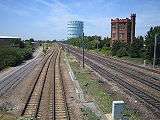
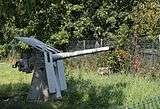 A naval gun that was at the Threebridges, Former part of the Outer London Defence Ring
A naval gun that was at the Threebridges, Former part of the Outer London Defence Ring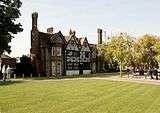 The Manor, Southall.
The Manor, Southall.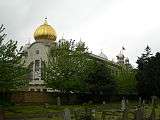 Sri Guru Singh Sabha Gurdwara
Sri Guru Singh Sabha Gurdwara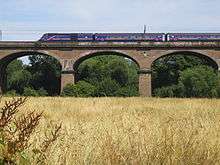 Wharncliffe Viaduct, viewed from the south side
Wharncliffe Viaduct, viewed from the south side Himalaya Palace Cinema
Himalaya Palace Cinema
| External image | |
|---|---|
Political representation
Southall is part of the parliamentary constituency of Ealing Southall, represented since 2007 by Labour Member of Parliament Virendra Sharma.
Southall is made up of five electoral wards for local council elections: Dormers Wells, Lady Margaret, Norwood Green, Southall Broadway and Southall Green, which all elect councillors to Ealing Council.
Southall is in the London Assembly constituency of Ealing and Hillingdon which has one assembly member: Richard Barnes (Conservative), who was re-elected in May 2008.
Transport and geography
Southall is served by Southall railway station on the Great Western Main Line, providing links to and from Heathrow Airport, Reading and Oxford as well as London Paddington.
There is no London Underground station in Southall, the nearest one to the town centre being Osterley station, on the Piccadilly line, which is located approximately 2 miles (3.2 km) to the south.
Frequent bus services link Southall with all neighbouring suburbs and Heathrow Airport.
There is an express coach service between Southall, Leicester and Birmingham which specialises in serving the many family connections in both areas' South Asian populations.
Education
Schools in Southall
- Villiers High School, located in the area
- Dormers Wells High School – located on Dormers Wells Lane.
- Ealing, Hammersmith and West London College, a campus is located on Beaconsfield Road in Southall.
- Featherstone High School, located in the area
- Acorn House College, located in the area
- Ayesha Siddiqa Girls School, located in the Abu Bakr Mosque[49]
See also
- Blair Peach, anti-racist campaigner was killed in a demonstration in Southall on Monday 23 April 1979.
- Southall rail crash
References
- Southall is made up of 5 wards in the London Borough of Ealing: Dormers Wells, Lady Margaret, Southall Green, Southall Broadway, and Norwood Green. "Archived copy". Archived from the original on 22 February 2014. Retrieved 9 June 2014.CS1 maint: archived copy as title (link)
- "Southall". hidden-london.com. Hidden London. Retrieved 14 November 2019.
- Mayor of London (February 2008). "London Plan (Consolidated with Alterations since 2004)" (PDF). Greater London Authority. Archived from the original (PDF) on 2 June 2010.
- "Archived copy". Archived from the original on 22 February 2014. Retrieved 9 June 2014.CS1 maint: archived copy as title (link)
- "Demographics". Hidden London. 30 January 2013. Retrieved 30 April 2020.
- "The UK's biggest South Asian Festival LONDON MELA powered by Let's Go Southall returns to Southall, the home of Europe's oldest South Asian community for a dazzling celebration of Asian culture, dance and music". new-mela2017launch.
- "U.K. - Southall - Serge :: Grace at the Fray". Serge. Retrieved 30 April 2020.
- Youngs, Frederic (1979). Guide to the Local Administrative Units of England. I: Southern England. London: Royal Historical Society. ISBN 0-901050-67-9.
- Great Britain Historical GIS / University of Portsmouth, Southall MB (historic map). Retrieved 4 August 2008.
- Great Britain Historical GIS / University of Portsmouth, Ealing LB (historic map). Retrieved 4 August 2008.
- "Southall, The Manor House 1965". Francis Frith. 25 October 2013. Retrieved 29 July 2015.
- 'Norwood, including Southall: Manors', A History of the County of Middlesex: Volume 4: Harmondsworth, Hayes, Norwood with Southall, Hillingdon with Uxbridge, Ickenham, Northolt, Perivale, Ruislip, Edgware, Harrow with Pinner (1971), pp. 43–45. Date accessed: 25 May 2010.
- David Bradley. "David Bradley Online – London Trolleybus Route 607 – Picture Gallery". Trolleybus.net. Retrieved 29 July 2015.
- "St John's Church Burial Ground". London Gardens Online. Retrieved 15 March 2016.
- Southall Film Studios Archived 5 February 2012 at the Wayback Machine
- "Boeing 707–321, N725PA, Pan American World Airways (PA / PAA)". Abpic.co.uk. 25 October 1960. Retrieved 29 July 2015.
- People's War Stories Archived 6 March 2012 at the Wayback Machine
- "RSG: Sites: Southall". Subbrit.org.uk. 26 June 2001. Retrieved 29 July 2015.
- "Brave Boy Rewarded Aka Carnegie Award To Brian Gibbons – British Pathé". Britishpathe.com. 12 March 2014. Retrieved 29 July 2015.
- Ealing Gazette (19 October 2007) Seven Killed as A Viking plane smashes houses.
- Kettle, Martin; Hodges, Lucy (1982). Uprising! Police, the People and the Riots in Britain's Cities. Pan Books. p. 60,156. ISBN 0330268457.
- "BBC On This Day | 23 | 1979: Teacher dies in Southall race riots". BBC News. 23 April 1979. Retrieved 29 July 2015.
- Marshall, George (1991). Spirit of '69 – A Skinhead Bible. Dunoon, Scotland: S.T. Publishing. ISBN 1-898927-10-3. p.107
- "Blair Peach: killed by police". Socialistworker.co.uk. Retrieved 29 July 2015.
- "Blair Peach: A 30-year campaign". BBC News. 25 June 2009. Retrieved 29 July 2015.
- "Race riot strikes London". Associated Press. 5 July 1981. Retrieved 12 January 2010.
- Bushell, Garry (2001). "Oi! – The Truth". Garry Bushell Uncensored. Archived from the original on 16 December 2009. Retrieved 12 January 2010.
- Baumann, Gerd (1996). Contesting culture: discourses of identity in multi-ethnic London. Volume 100 of Cambridge studies in social and cultural anthropology. Cambridge University Press. ISBN 0-521-55554-X.
- Axel, Brian Keith (2001). The nation's tortured body: violence, representation, and the formation of a Sikh "Diaspora". Duke University Press. ISBN 0-8223-2615-9.
- Robb, John (2006). Punk Rock: An Oral History (London: Elbury Press). ISBN 0-09-190511-7
- Marshall, George (1991). Spirit of '69 – A Skinhead Bible. Dunoon, Scotland: S.T. Publishing. ISBN 1-898927-10-3. pp.107–8
- Marshall, George (1991). Spirit of '69 – A Skinhead Bible. Dunoon, Scotland: S.T. Publishing. ISBN 1-898927-10-3. pp.106 & 110
- Harcourt, Gordon (4 May 2005). "British Asians' immigration fears". BBC News. Retrieved 21 March 2009.
- Philipose, Pamela (13 July 2003). "Voice from Little India". Indian Express. Retrieved 13 December 2009.
- Dhaliwal, Nirpal (22 July 2007). "Cameron is given a black eye by the real Southall". The Sunday Times. London. Retrieved 13 December 2009.
- Bhamra, Kuljit (6 April 2009). "The (untold) Southall Story". Asians in Media Magazine. Retrieved 13 December 2009.
- Rappeport, Alan (29 January 2006). "A Real Taste of South Asia? Take the Tube to Southall". New York Times. Retrieved 13 December 2009.
- Diversity Commission for Racial Equality Archived 13 October 2007 at the Wayback Machine
- Johnston, Philip (6 October 2006). "Diversity index reveals Britain's ethnic mix". The Daily Telegraph. London. Retrieved 23 May 2010.
- "Southall Mosques – Masjids – Islamic Places of Worship". Visitsouthall.co.uk. Retrieved 29 July 2015.
- McKibbin, Ross; Mc Hissun, R. (1998). Classes and Cultures: England 1918–1951 – Ross McKibbin. ISBN 9780198206729. Retrieved 29 July 2015.
- http://www.ukcensusdata.com/ealing-e09000009
- "Ward Profiles and Atlas – London Datastore".
- "Demographics". Hidden London. 30 January 2013. Retrieved 30 April 2020.
- Friar's Lawn Archived 22 March 2012 at the Wayback Machine
- The Graham Rye Interview| The Graham Rye CBn Interview (Part I)
- "Sir Leslie Murphy". The Daily Telegraph. London. 8 October 2007. Retrieved 23 May 2010.
- London Southall Gasworks at flickr
- Home page. Ayesha Siddiqa Girls School. Retrieved on 15 June 2016. "We are located on the second and third floors of Abu bakr Mosque in Southall, in the London Borough of Ealing,[...]" – Address Archived 24 June 2016 at the Wayback Machine: "165–169 The Broadway Southall Middlesex UB1 1LS"
Further reading
External links
| Wikimedia Commons has media related to Southall. |
